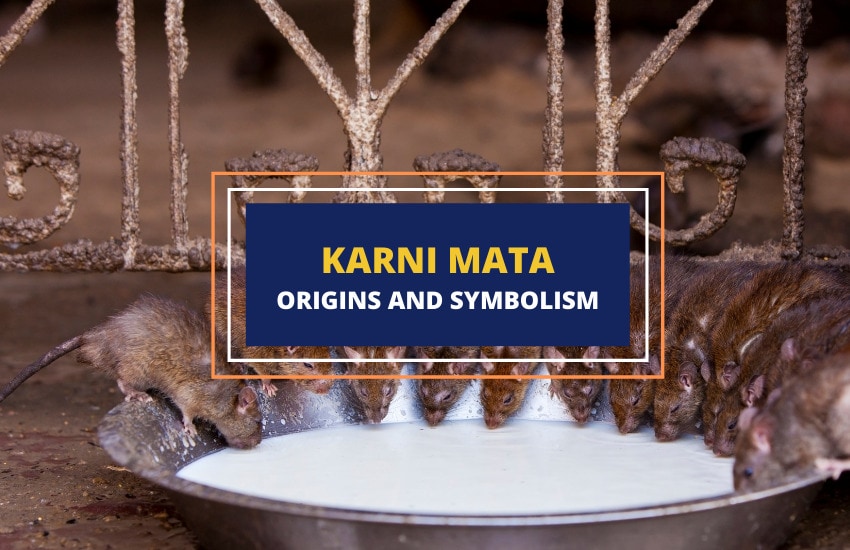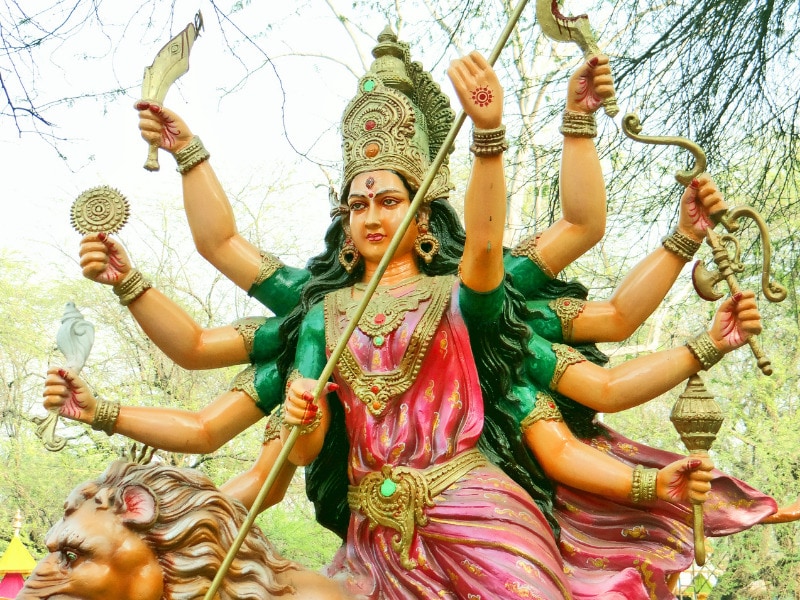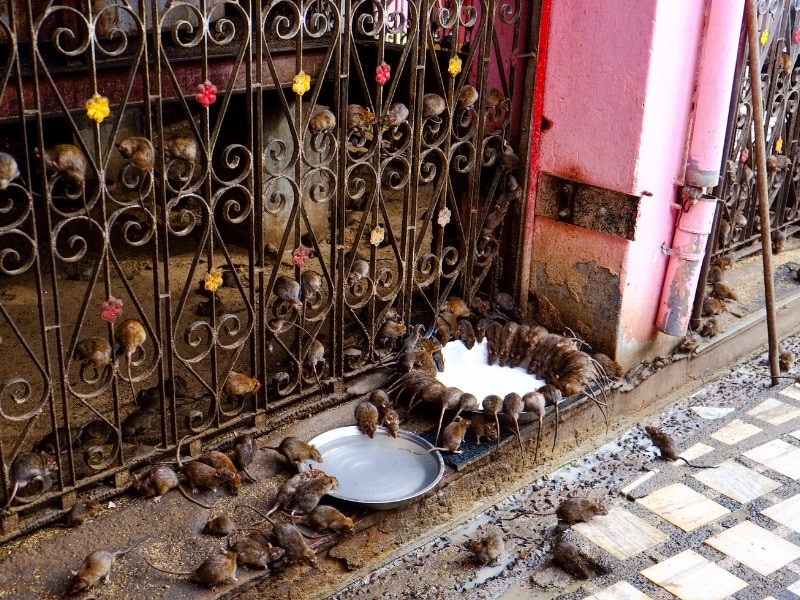
Table of Contents
Hinduism is renowned for its thousands of gods and goddesses who have multiple incarnations. One of the incarnations of Hindu goddess Durga, Karni Mata, was exceptionally honored during her lifetime and became an important local goddess. Read further to learn more about Karni Mata, and the spiritual significance of the rats in her temple in Rajasthan.
Origin and Life of Karni Mata

In Hindu tradition, it’s believed that the Hindu goddess Durga, also known as Devi and Shakti, was supposed to be incarnated as a Charan woman. The Charans were a group of people who were mostly bards and storytellers and served the kings and aristocrats. They played a significant role in a monarch’s reign, and composed ballad poetry associating the monarchs of their day with those of mythological times.
Karni Mata is one of the Charani Sagatis, the goddesses of Charan traditions. Like other Sagatis, she was born into a Charan lineage and was regarded as the defender of her realm. She was the seventh daughter of Meha Khidiya and her birth has been dated from around 1387 to 1388. At a very early age, she revealed her divine nature through her influential charisma and miracles.
Karni Mata was recognized for curing people of sickness, saving them from snakebites, and granting them a son. During her lifetime, she was a disciple of the goddess Avar, and became an influential leader among the Charans. It’s said that she owned large herds of oxen and horses, which helped her gain wealth and influence, and bring change and prosperity to the community.
Karni Mata married and had children with Depal of the Rohadiya Vithu Charan lineage from the Satika village. He was considered to be an incarnation of the Hindu god Shiva. After her marriage, Karni Mata continued to perform many miracles. It’s believed that the goddess died near Dhineru Lake in Deshnok after “leaving her body”.
Iconography and Symbolism
Most depictions of Karni Mata portray her sitting in a yogic posture, carrying a trident in her left hand, and the head of the buffalo demon Mahishasur in her right. However, these depictions of her were derived from those of the goddess Durga who was represented killing the buffalo demon with her bare hands—and later using a trident as a weapon.
The attribution of the slaying of the buffalo to Karni Mata is associated with the myth of her victory over Yama, the Hindu god of the dead who is commonly depicted riding a buffalo. In a legend, the souls of devotees are spared from Yama’s hand with the intervention of the goddess. It’s also based upon the representation of Durga as the goddess of war.
Karni Mata is also depicted wearing the traditional headwear and skirt of western Rajasthani women, the oṛhṇi, and the ghagara. She’s also portrayed with a double garland of skulls around her neck, and rats around her feet. In devotional pictures, she’s sometimes shown sporting a gray beard, which implies her miraculous powers, as well as holding a string of beads called mala.
The Karni Mata Temple in Rajasthan

At the Karni Mata Temple of Deshnok, thousands of rats live a comfortable life under absolute protection. They’re regarded as vehicles of the souls of departed devotees of Karni Mata waiting to be reborn. The black rats in the temple are considered auspicious, but the white ones are even more auspicious. In fact, devotees and curious travelers wait for hours to spot the white rats.
The popular media suggests that it’s the rats, or the kabbas, meaning little children, who are worshipped in Karni Mata’s Temple, but it’s actually the goddess herself. During the Karni Mata fair, many people go to the temple to pay homage and receive blessings from the goddess, especially newlywed couples and grooms-to-be.
The Legend of Laxman
The spiritual significance of the rats in Karni Mata’s temple stems from a popular Hindu legend. In the story, Laxman, one of Karni Mata’s sons, drowned in the Kapil Sarovar Lake in Kolayat. Many believe that he had been drinking water, leaned in too far over the edge, and slipped into the lake. So, Karni begged Yama, the god of the dead, to bring her son back to life.
In one version of the legend, Yama agreed to bring Laxman back to life only if Karni Mata’s other male children would live as rats. Out of desperation, the goddess agreed and all her sons turned into house rats. In another version, Yama didn’t cooperate, so the goddess had no choice but to use the body of a rat to store the boy’s soul temporarily, safeguarding him from the hands of Yama.
Since then, the Karni Mata Temple has become the home of rats or kabbas, who are hiding from the wrath of Yama. Therefore, it’s forbidden to disturb, injure, or kill them—and accidental deaths would require replacing the rat with a solid silver or gold statue. Worshippers feed the rats with milk, grains, and sweet holy food called prasad.
Significance of Karni Mata in Indian History
Several accounts reveal the strong connections between Karni Mata and some Indian rulers, as shown in the poetry and songs of the Charans and the Rajputs—the descendants of the Kshattriya warrior ruling class. Many Rajputs even link their survival or community’s existence to the help of the goddess.
In 15th-century India, Rao Shekha was the ruler of Nan Amarsar of Jaipur State, where the region comprised the districts of Churu, Sikar, and Jhunjhunu in modern-day Rajasthan. It’s widely believed that the blessing of Karni Mata helped him to conquer his enemies and strengthen his rule.
Karni Mata also supported Ranmal, the ruler of Marwar from 1428 to 1438, as well as his son Jodha who founded the city of Jodhpur in 1459. Later, Jodha’s younger son Bika Rathore also received special patronage from the goddess, as she provided him with 500 oxen for his conquest. She miraculously drew the bows of Bikaner’s army with “invisible hands,” which defeated their enemies from a safe distance.
As gratitude for Karni Mata’s provisions, the heirs to Bikaner’s throne remained loyal to the goddess. In fact, the Karni Mata temple was built in the 20th century by Maharaja Ganga Singh of Bikaner. It has become the most important place of pilgrimage for devotees since the division of India and Pakistan in 1947.
FAQs About Karni Mata
Yes, pilgrims and visitors are allowed to take pictures but a special ticket will need to be purchased if you use a camera. If you use a mobile phone, there is no charge.
Pilgrims and visitors to the temple feed the rats. The temple overseers – members of the Deepavats family – also provide food for them in the form of grain and milk. The food is placed on the floor in dishes.
There are around twenty thousand black rats at the temple. There are also a few white ones. These are considered very lucky to see as they are believed to be earthly manifestations of Karni Mata and her sons.
Interestingly, there have been no reported cases of plague or other rodent-borne diseases in the vicinity of the Karni Mata temple. However, the rats themselves become sick fairly often from all the sweet food they’re fed. Many succumb to stomach ailments and diabetes.
In Brief
Apart from Hindu deities, the Hindus are often known to pay homage to incarnations of gods and goddesses. An incarnation of Hindu goddess Durga, Karni Mata lived in the 14th century as a sage and mystic, being one of the Charani Sagatis of the Charans. Today, her temple in Rajasthan remains one of the most bizarre tourist attractions in the world.








